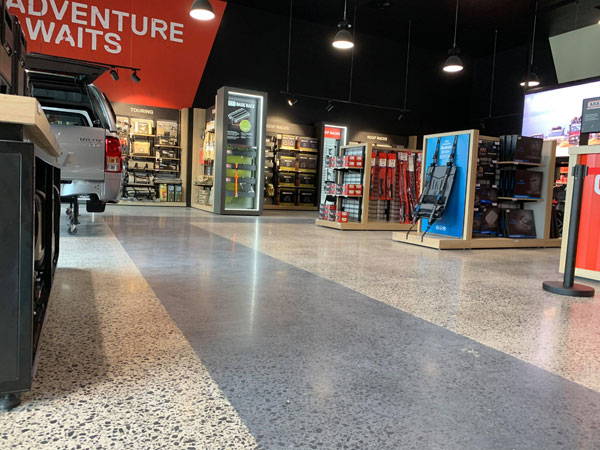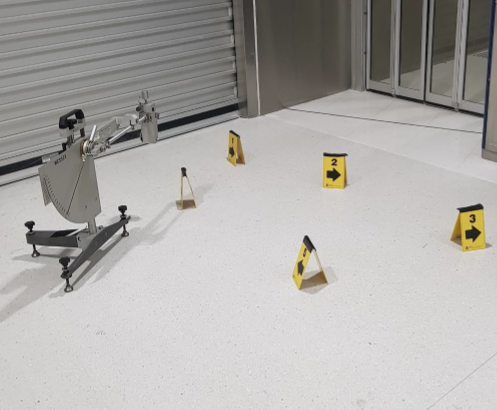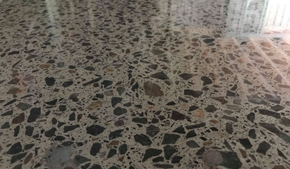
In Australia, the non-slip rating system for flooring is called the Slip Resistance Classification. It measures how slip-resistant a surface is under various conditions, particularly when wet. Like with any flooring type, it is important to understand when and where polished concrete and terrazzo can be affected by slip ratings. There are two standards that are followed AS 4586 and AS 4663.
AS4663 Standard
AS 4663 is the Australian Standard for "Slip Resistance Measurement of Existing Pedestrian Surfaces." It provides guidelines and methods to assess the slip resistance of surfaces that are existing or already installed.
AS 4586 Standard
This standard outlines the test methods and classifications for slip resistance of new or planned pedestrian surfaces. It includes various tests to simulate real-world conditions, such as walking on wet surfaces, inclines, or areas with contamination.

The main testing proceedures used are:
R-Rating (Ramp Test):
The R-Rating is derived from a ramp test, where a person walks on an inclined surface covered with oil to determine the angle at which they start slipping. This rating is common for commercial and industrial settings where oils or other slippery substances may be present.
Pendulum Test (P-Rating):
The Pendulum Test uses a swinging arm with a rubber slider to simulate a person’s heel striking the floor. This test is performed in both dry and wet conditions. The results are classified from P0 to P5, with P5 being the highest slip resistance.
Tortus Tribometer (Dry floor friction test method):
The test is performed using a device called the Tortus Tribometer. This device moves across the surface being tested and measures the coefficient of friction (COF), which indicates the amount of grip the surface provides.
Results:
-
R-Rating - Often used for tiled surfaces, the R-rating (R9 to R13) measures slip resistance on an incline. The higher the number, the more slip-resistant the surface.
- R9 - 6° to 10° incline : Low slip resistance (mostly used for indoor areas).
- R10 - 10° to 19° incline: Moderate slip resistance.
- R11 - 19° to 27° incline: Suitable for areas prone to water spillage.
- R12 - 27° to 35° incline: High slip resistance (e.g., commercial kitchens).
- R13 - More than 35° incline: Very high slip resistance (e.g., swimming pool surrounds).
-
P-Rating - The Pendulum Test (P0 to P5) measures slip resistance in both wet and dry conditions.
- P0 - BPN less than 12 : Very low slip resistance (potentially unsafe in wet areas).
- P1 - BPN 12-24: Low slip resistance, not suitable for wet areas.
- P2 - BPN 25-34: Suitable for dry areas or areas with minimal wet exposure.
- P3 - BPN 35-44: Suitable for areas with occasional water, such as bathrooms and corridors.
- P4 - BPN 45-54: Suitable for frequently wet areas like entrances, bathrooms, and kitchens.
- P5 - BPN 55+: Highest slip resistance, suitable for areas like commercial kitchens, swimming pool surrounds, and areas with constant water or grease exposure.
- Dry Floor Friction Test
- >0.4 - moderate to very low risk of slipping when dry
- <0.4 - high to very high risk of slipping when dry
These ratings are critical for compliance with Australian building codes and safety regulations, especially in public or commercial spaces. Slip resistance can vary greatly between dry and wet conditions. A surface that may perform well in dry conditions might not perform the same when wet. Testing under both conditions helps ensure the safety of different environments. Wet testing is particularly important for areas like, pool decks, bathrooms, entrances and lobbies, kitchens, public walkways etc. By understanding what is required in each area and how testing is completed you can better choose what type or finish of polished concrete, terrazzo or epoxy is needed.
There are some common environments that have required ratings. It is important when advising clients on finishes that you understand the requirements of slip testing.
- Bathrooms: P2-P3
- Residential Outdoor Areas: P3-P4 (depending on water exposure)
- Hotels/schools: Wet Areas P3/R10 most other areas P2/R9
- Shopping Centres: P3 for indoor spaces such as foodcourts supermarkets or shop entry areas from outside.
- Commercial Kitchens: P5 or R13 for greasy, wet areas.
- Restaurants and Cafés: P1 - P3 for dining areas depending on several factors, P4-P5 for kitchen areas.
- Swimming pools and sporting facilities: ramps and stairs P5, pool surrounds and change rooms P4
- External Stairs and Ramps: start at P3 or R10 for undercover areas and increase to P5 or R12 depending on the slope of the surface.
Additional Considerations
Surface Material: The material of the surface plays a significant role in its slip resistance. Tiles, concrete, wood, and carpets all have different properties when it comes to wet or dry friction. The types of sealers used will also affect the dry and wet friction.
Maintenance: A surface’s slip resistance can degrade over time due to wear, contamination, or improper cleaning. Regular maintenance is crucial to preserve slip-resistant properties.
Slip resistance testing is vital in ensuring the safety of high-traffic areas, particularly where moisture is prevalent, and it is important you understand what you product can deliver and whether it is appropriate for the needs of the floor.












